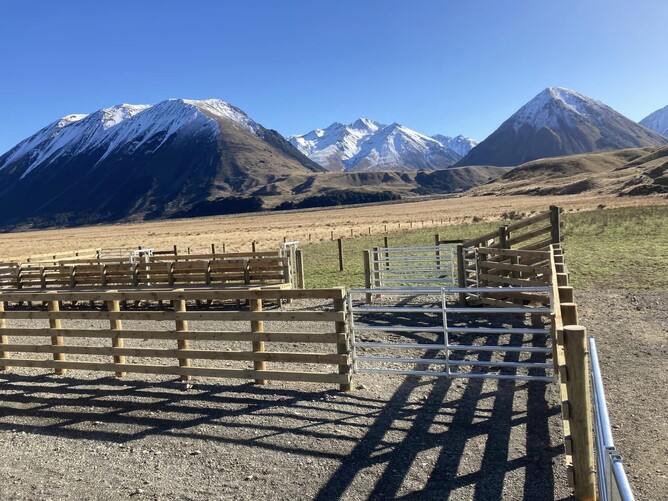When it comes to farming in Canterbury’s high country, I know how challenging it can be to find stockyards that can stand up to the unique conditions out here. The rugged terrain, unpredictable weather, and demands of livestock handling all mean that high-country stockyards need to be built tough and smart.
At Hughes Fencing & Earthworks, we’re not just building stockyards; we’re crafting durable, efficient solutions designed to thrive in the high country. Here’s a closer look at what goes into a stockyard that can withstand Canterbury’s conditions and how we approach each project to make sure it delivers.
Building for the High Country: Why Quality and Adaptability Matter
Stockyards are one of the most important structures on any farm, but the high country brings its own set of challenges. Between the weather and the landscape, these stockyards need materials and layouts that go beyond the basics.
1. Weather-Resistant Materials: Built to Withstand Canterbury’s Elements
Out in mid-Canterbury’s high country, stockyards are constantly exposed to harsh conditions. High winds, heavy rain, and even snow can all take a toll on standard fencing and materials. That’s why we rely on weather-resistant, high-quality materials like Summit Steel Wire and Tornado Gates—both designed to handle whatever the environment throws at them. With these materials, we know the fencing won’t rust, sag, or break down after a season of tough weather.
Using weather-resistant materials doesn’t just improve the lifespan of the stockyard—it also means fewer repairs and less maintenance, which makes a difference over the years. Farmers in the high country need stockyards they can count on without constantly having to patch things up, and that’s where using the right materials truly matters.
2. Adaptable Layouts for Challenging Terrain
One of the things I appreciate most about working in Canterbury’s high country is the land itself, but that terrain can make designing a functional stockyard a real challenge. We’ve got to work with slopes, rocky patches, and uneven ground, all while making sure the layout allows for efficient livestock handling.
When designing a stockyard, I focus on layouts that are adaptable—ones that can work with the land, not against it.
For instance, I often incorporate angled yards or sweeping circular pens that make it easier to move livestock with minimal stress, even on uneven ground. These adaptable layouts also help make the most of available space, providing safe handling areas without sacrificing efficiency.
Plus, having a layout that flows smoothly can actually reduce stress on animals and workers alike, which goes a long way in creating a productive, safe environment.
Key Features for Efficiency in High-Country Stockyards
In addition to durability, efficiency is a top priority for any high-country stockyard. Farmers need to move livestock quickly, safely, and with minimal fuss, and a well-designed stockyard can make all the difference. Here’s what I make sure to include in each project to maximise efficiency:
1. Reliable Gates and Entry Points
In any stockyard, having secure gates that can withstand impact is essential, but in the high country, it’s especially crucial. Gates need to be sturdy enough to hold back livestock and resist the elements, and they also need to be easy to open and close.
I trust Tornado Gates for this, as they’re built for strength and reliability. These gates aren’t just durable—they’re also designed to make it easy for farmers to control animal flow, which is key for safe and efficient handling.
2. Solid Posts and Secure Fencing
The backbone of any good stockyard is its fencing, and in the high country, that backbone has to be extra strong. I use Summit Steel Wire because it’s high-tensile, which means it can withstand the pushing and rubbing that livestock tends to do without giving in.
We make sure every post is securely set, whether on rocky ground or softer soil, to provide a strong foundation that keeps everything stable, no matter the conditions.
3. Space for Easy Movement and Low-Stress Handling
Moving livestock efficiently is all about understanding animal behaviour. In the high country, this is especially important, as animals can be a bit more unpredictable. I focus on designing wide lanes and strategically placed pens that give livestock enough room to move without feeling crowded, which helps reduce stress.
By designing yards that encourage smooth movement, farmers can work faster, and animals stay calmer—a win-win for everyone.
Why Choose Hughes Fencing & Earthworks for Your High-Country Stockyard?
At Hughes Fencing & Earthworks, we understand that high-country farming requires more than a standard approach. Every stockyard we build is customised to the specific needs of the land and the livestock, ensuring it can handle the demands of the high country.
I take pride in knowing that when we build a stockyard, it’s going to provide farmers with a durable, efficient, and safe handling environment for years to come.
With top-quality materials, adaptable designs, and a commitment to craftsmanship, we’re here to create stockyards that meet the challenges of mid-Canterbury’s high country head-on. Whether it’s selecting weather-resistant wire or designing layouts that flow with the landscape, every decision we make is about giving farmers a stockyard that’s built to last and built to work.
If you’re ready to upgrade your stockyard or need a new one built from scratch, get in touch with us at Hughes Fencing & Earthworks. We’re here to bring our high-country expertise to your farm and deliver a stockyard that supports your livestock handling needs in every way.




